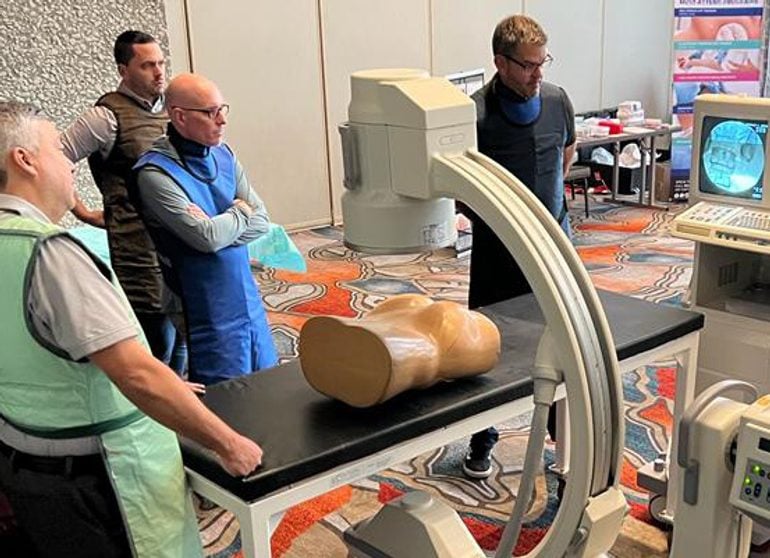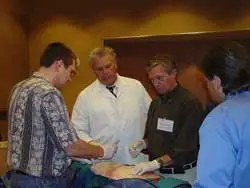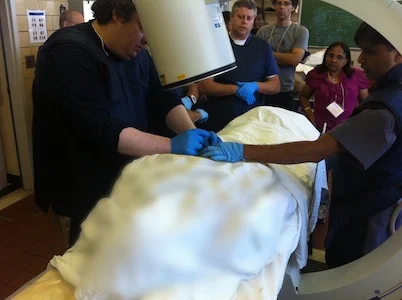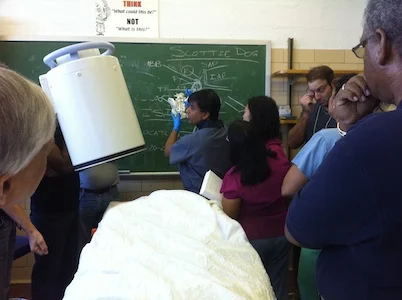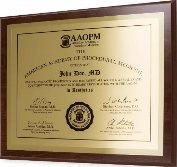Day 1
7:00am–7:30am
Check-in and registration.
7:30am–8:00am
Overview of essential supplies and medications used in pain management, including guidance on sourcing and patient-specific application, focusing on pharmacologic and corticosteroid options.
8:00am–8:45am
Detailed anatomy of the lower spine and sacroiliac region, emphasizing key anatomical landmarks for accurate needle placement. Neuroanatomical pathways and injection depth/safety will also be covered.
8:45am–9:00am
Break
9:00am–11:00am
Instruction on diagnostic and therapeutic lumbar facet joint injections using both palpation techniques and image guidance, including ultrasound and fluoroscopy methods.
11:00am–12:00pm
Joint aspiration and injection techniques for various joints: sacroiliac, shoulder, AC, hip, knee, and digits. Introduction to ultrasound and image-guided procedures, with emphasis on safety and compliance.
12:00pm–1:00pm
Lunch
1:00pm–2:00pm
Exploration of regenerative therapies like prolotherapy, PRP, botulinum toxin, and biologics for soft tissue conditions including neuropathies, scar tissue, and muscle spasticity.
2:00pm–3:00pm
Therapies for joint lubrication and myofascial pain relief, including viscosupplementation and trigger point injections.
3:00pm–3:15pm
Break
3:15pm–4:30pm
Identification and treatment options for lumbar spine conditions such as herniated discs, spinal stenosis, instability, spondylolysis/listhesis, and degenerative disc disease. Alternatives like fusion and TDR will be discussed.
4:30pm–5:15pm
Non-destructive lumbar facet therapies including diagnostic, therapeutic, and neurolytic procedures. Practice includes hands-on sessions with live volunteers or models using non-imaging approaches.
5:15pm–6:00pm
Intro to fluoroscopy in pain management, covering pathology review, fluoroscopic imaging, needle targeting, radiation safety, dosage management, and standard protocols per NCRP guidelines.
Day 2
7:30am–8:00am
Day two registration. Participants divided into small working groups (A & B).
8:00am–9:15am
FDA-approved contrast agents used under fluoroscopy are reviewed. Fluoroscopic techniques for transforaminal epidurals, nerve root, and medial branch blocks are discussed, including physical exam indicators and patient positioning.
9:15am–10:15am
Discussion of advanced facet joint injection techniques including diagnostic, therapeutic, and neurolytic methods. Overview of transforaminal and translaminar epidural injection procedures.
10:15am–10:30am
Break
10:30am–12:00pm
Hands-on practice using cadaveric or anatomical models. Training includes fluoroscopic guidance for lumbar and sacroiliac joint injections.
12:00pm–1:00pm
Lunch
1:00pm–2:15pm
Clinical strategies for managing chronic pain and opioid prescriptions. Topics include patient assessment, medication alternatives, contracts, testing protocols, and legal requirements.
2:15pm–3:30pm
Proper medical billing practices for procedures: facet joint injections, arthrocentesis, trigger point injections, and prolotherapy. Focus on coding accuracy and reimbursement guidelines.
3:30pm–3:45pm
Break
3:45pm–4:45pm
Live demonstration and final instructional session on trigger point and joint injections. Final certification in pain management awarded upon completion.
4:45pm–6:00pm
Optional lab time for continued practice on cadaver or anatomical models. Extra training on image-guided lumbar and sacroiliac injections, as well as trigger point techniques.
DISCLAIMER: The following is a summary of the course agenda. The full course agenda will be emailed to you a few days prior to the course. If you have any questions or need additional information, please contact our office.
